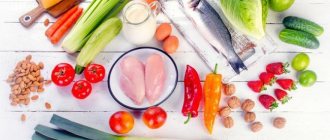Glucose and cholesterol
What is glucose?
In the human body, glucose is the main and most universal source of energy for metabolic processes, the “single energy currency” of the body. All cells of the body have the ability to metabolize glucose.
Due to the exceptional importance of maintaining a stable level of glucose in the blood, humans have a complex system of hormonal regulation of carbohydrate metabolism parameters.
More than half of the energy consumed by a healthy body is generated through the oxidation of glucose. Glucose and its derivatives are present in most organs and tissues. The main sources of glucose are sucrose, starch from food, glycogen reserves in the liver, as well as glucose formed in synthesis reactions from amino acids and lactate. The concentration of glucose in the blood is a derivative of the activity of the processes of glycogenesis, glycogenolysis, gluconeogenesis and glycolysis. The concentration of glucose in the blood is regulated by hormones: insulin is the main hypoglycemic factor, and other hormones - glucagon, somatotropin (GH), thyrotropin (TSH), thyroid hormones (T3 and T4), cortisol and adrenaline cause hyperglycemia (counterinsular effect). The concentration of glucose in arterial blood is higher than in venous blood, because There is a constant utilization of glucose by tissues. Glucose is not normally excreted in urine. When the level of glucose in the blood increases to 10 mmol/l (the renal threshold for glucose), it begins to appear in the urine.
Indications for the purpose of analysis:
- insulin-dependent and non-insulin-dependent diabetes mellitus (diagnosis and monitoring of the disease);
- pathology of the thyroid gland, adrenal glands, pituitary gland;
- liver diseases;
- determination of glucose tolerance in individuals at risk of developing diabetes mellitus;
- obesity;
- pregnancy diabetes;
- impaired glucose tolerance.
Preparation for the study: on an empty stomach, no less than 8 hours (!) after the last meal, it is advisable to take blood in the morning. It is necessary to exclude increased psycho-emotional and physical stress. Material for research: serum or plasma. Execution time: 1 working day
What is total cholesterol (cholesterol, Cholesterol total)?
Cholesterol (cholesterol) is a secondary monohydric cyclic alcohol. It is found in the blood and tissues of the body in free and esterified forms. Free cholesterol is a component of cellular plasma membranes, as well as mitochondrial membranes and the endoplasmic reticulum. Its esters predominate in blood serum. Cholesterol is a precursor of sex hormones, corticosteroids, bile acids, vitamin D. Up to 80% of cholesterol is synthesized in the liver, and the rest enters the body with products of animal origin (fatty meat, butter, eggs). Cholesterol is insoluble in water; its transport between tissues and organs occurs due to the formation of lipoprotein complexes. There are low-density lipoprotein (LDL) and high-density lipoprotein (HDL) cholesterol fractions that differ in composition and function. Cholesterol level at birth is below 3.0 mmol/L. With age, its level in the blood increases, and gender differences in concentration appear. In men, cholesterol levels rise in early and middle age and decline in old age. In women, the concentration of cholesterol increases more slowly with age, until menopause, and subsequently may exceed the level in men. This is due to the action of sex hormones. Estrogens reduce, and androgens increase, total cholesterol levels. Cholesterol accumulation is a risk factor for the development of atherosclerosis and coronary heart disease (CHD). A high risk of developing coronary artery disease in adults is a cholesterol concentration in the blood above 6.22 mmol/l. When the concentration of total cholesterol is in the range of borderline values and above, it is advisable to study cholesterol in combination with the determination of triglycerides, HDL and LDL cholesterol.
Indications for the purpose of analysis:
- atherosclerosis and related diseases of the cardiovascular system: coronary heart disease, myocardial infarction (prediction, risk assessment, diagnosis);
- liver and kidney diseases;
- endocrine pathology (myxedema, diabetes mellitus).
Preparation for the study: blood must be donated in the morning, strictly on an empty stomach, no less than 12 hours after the last meal. Material for research: serum. Execution time: 1 working day.
Section materials
December 23, 10:55
Faster than delta. Doctors warned about the high contagiousness of omicron
December 15, 12:54
Everybody dance! How to maintain quality of life in old age?
December 15, 12:54
Don't let go. The doctor talks about the appearance of blood clots in the body
07 December, 11:05
Under double attack. The incidence of influenza and ARVI is growing in St. Petersburg
December 03, 13:09
Model hospital. How the colony for the insane worked in St. Petersburg
How to quickly and effectively lower cholesterol using folk remedies
In the meantime, everything is not so bad, here are some folk recipes that help in the fight against high cholesterol.
Recipe No. 1
Ingredients
- 350 g garlic
- 200 g alcohol
Preparation
Grind the garlic in a meat grinder and pour a glass of alcohol or vodka, let it brew in a dark place for 10 days.
The product should be consumed gradually, starting with 2 drops, increasing to 15-20 drops over the course of a week, 3 times a day before meals, preferably diluting the tincture with milk. Then also stop taking from 20 drops to 2 over the next week. This method should not be repeated often, once every 3 years is enough.
Recipe No. 2
Ingredients
- half a cup of dill seeds
- 1 tbsp. spoon of valerian root
- 1 glass of honey
Preparation
The chopped root, dill and honey should be mixed thoroughly. Then add 1 liter of boiling water to the mixture and let it sit for 24 hours. Keep the resulting infusion in the refrigerator and consume 1 tbsp. spoon 3 times a day 30 minutes before meals.
Recipe No. 3
Ingredients
- 2 cups olive oil
- 10 cloves of garlic
Preparation
This is a fairly simple way to create garlic oil, which can be used for any dish, as a seasoning for salads and other foods. Simply peel the garlic, press it through a garlic press, and steep it in olive oil for a week—an excellent cholesterol-lowering garlic oil.
Well, that's all for me today. Be healthy!
ul
Manifestations of diabetes mellitus
Diabetes mellitus is considered the most common disease, diagnosed in approximately 6% of the population.
The earlier the disease is detected, the greater the chances of quality treatment and maintenance of the body.
The main manifestation of diabetes of any type is that cells stop using glucose energy. Blood sugar levels rise to a certain level.
Further, depending on the type of diabetes mellitus, other symptoms appear:
- Type 1 diabetes manifests itself at an early age. In this case, frequent infectious diseases occur. It does not affect metabolism, which means it keeps the patient’s weight unchanged. Main symptoms: sudden weight loss, drowsiness, fatigue, desire to drink, frequent urge to go to the toilet.
- Type 2 disease occurs in people over 45 years of age. As a result of improper absorption of glucose by cells, sick people experience problems with excess weight. Obesity is the main symptom of diabetes. Symptoms vary: thirst, tingling in the fingers, dry skin, nausea, obesity, high blood pressure.
- Gestational diabetes is a special type of disease, and most importantly, temporary. Most often it occurs during pregnancy and disappears after its completion. During the period of bearing a child, a woman’s body may not be able to cope with the double load on the pancreas.
Any type of diabetes has a huge risk for the health and life of the patient. The disease causes many complications.
ul
How to find out your cholesterol level?
Doctors check cholesterol levels using a total cholesterol blood test. To do this, blood is taken from a vein in the treatment room. This analysis is basic. Your cholesterol level is considered high if your levels exceed 4.8 mmol/L.
There is also an extended comprehensive analysis that evaluates the state of fat metabolism - this is a lipid profile. This laboratory test, in addition to total cholesterol, examines the level of triglycerides and lipoproteins in the blood. You can learn more about this analysis (here).
Get tested
If you are in doubt about the choice of laboratory testing, make an appointment with a therapist or consult by phone
+7
Foods that reduce high glucose levels
It is possible to normalize blood sugar concentrations without the use of medications. A well-chosen menu that includes foods that lower blood sugar will help stabilize glucose levels.
Glycemic index (GI) is an indicator that reflects the effect of carbohydrates in foods on changes in blood sugar levels after consumption. This is what you need to focus on in order to understand which foods quickly and effectively lower blood sugar. It is the main guideline when choosing the components of a healthy diet.
There are no products that literally lower blood sugar. There are only foods that simply do not increase glucose levels.
Any raw vegetables, stewed or boiled, can be considered products that, if they do not reduce, then certainly do not lead to a rapid and strong increase in its level in the blood.
A diet designed to reduce glycemia does not involve the use of some expensive or exotic food. Products that quickly and effectively lower blood sugar are available in almost every home.
To create the right menu that will help reduce glycemia, you need to take into account the glycemic index of foods. The maximum GI is 100, which is considered pure glucose.
The lower the glycemic index and number of bread units (XE) of a product, the slower the rise in blood sugar after consumption. Glucose balance is also restored quite quickly.
A bread unit is a conventional indicator used to determine the approximate amount of carbohydrates in products. 1 XE is approximately equal to 10-13 grams of carbohydrates. Counting bread units is paramount in ensuring control over GI in diabetes mellitus.
We suggest you read: Blood sugar test 5 9
For glycemia, it is recommended to know which foods lower blood sugar. In this case, you should approach food intake by adhering to certain rules:
- Compliance with the diet - you should eat at the same time every day.
- Fractional meals - the daily portion of food is divided into 5-6 meals.
- Eating foods high in fiber - beans, peas.
- The predominance of vegetables in the daily menu.
- The calorie content of the foods consumed should be average.
- Adding milk and dairy dishes to the diet.
- Drink enough fluid – 1.5 – 2 liters per day.
- If you deviate from your usual diet for more than 1 hour, you should eat a slice of bread, any fruit (sour) or drink 200-250 ml of juice.
- Exclusion from the diet of alcoholic beverages.
- Control of the salt regime, in the direction of reducing salt.
- Limit fried, spicy, smoked foods.
- Exclusion from the daily menu of fatty, high-carbohydrate foods.
- Minimizing the consumption of animal fats.
- Presence of vitamins in the menu.
If your blood sugar is high, it is recommended to exclude high-carbohydrate foods from your usual diet.
ul
Sugar
All of humanity has risen to fight sugar. This is understandable: diabetes is a dangerous, widespread and incurable disease. Therefore, we do not recommend consuming sugar, and some are even prohibited. And on the other hand?
Once upon a time, I spontaneously had a thought: we don’t know what sugar really is. We treat it somewhat simply. They looked at its crystal lattice, found nothing in it (neither vitamins nor other useful substances) and decided that sugar is a useless product, at a minimum, and even a harmful product, at a maximum.
Question answer
Will giving up sweets affect brain function? I tried to remember, if not a large-scale, but at least some more or less thoughtful study of sugar and its effect on the human body (except for the well-known harmful one, of course) - and I didn’t remember, I didn’t come across such a scientific work.
However, interesting information still appeared. In Italy there is an entire institute that studies human taste. And the taste of sweets as well. In order to help humanity in the fight against diabetes, scientists decided to try to turn off the taste for sweets, naturally, first in experimental mice. We learned and turned it off. And they achieved what they wanted: the mice became indifferent to sugar, and they did not eat it. In general, they gave up sweets and... stopped reproducing! It was the male mouse that no longer wanted to mate with his girlfriends. And why did they need it now if they stopped producing semen? Fortunately, the process turned out to be reversible. The mice regained their sense of taste for sweets, they began to eat it again, and gradually sperm production was restored.
Now five tastes are known - sour, bitter, salty, sweet, and the recently added “taste of tastes”, discovered by Japanese scientists. The taste of fat is coming. He has already been discovered, but has not yet been included in the official top five. (I suppose it is still “recognized.”) Think for a moment, of all the listed tastes, which one is most dear to us? Yes, sweet, of course! Admit it honestly, how all these cakes, pastries, and sweets beckon and attract us. Remember the golden brown crust on fried meat, the mere sight of which makes your mouth water. But this attractive crust is nothing more than baked sugar contained in the meat! What food does our brain prefer? Yes sugar, of course. From it he best and fastest draws energy for his activities. Well, why, tell me, did nature need this - to stimulate us to eat sweets? So that we end up being banned?
I think we just don't understand sugar. Maybe that is why he cripples us so much, that due to our ignorance we treat him incorrectly? We treat it somehow childishly - either allow it or prohibit it. How will be correct? And if scientists understand the essence of sugar, maybe our attitude towards it will change radically?
Article on the topic
Maple syrup, molasses and 6 more natural sugar substitutes Since we are talking about sugar here, I will mention another paradoxical point of view. There are many scientific studies that claim that there are foods that lower blood sugar levels. On the other hand, there are very authoritative scientists who claim that “not a single food product has a glucose-lowering effect!” And what should we, potential patients, do about it? It’s easier for doctors - they stand by their positions, rejecting “foreign” ones, and it is according to their knowledge that they prescribe treatment. But we want the best, we need to get better!











